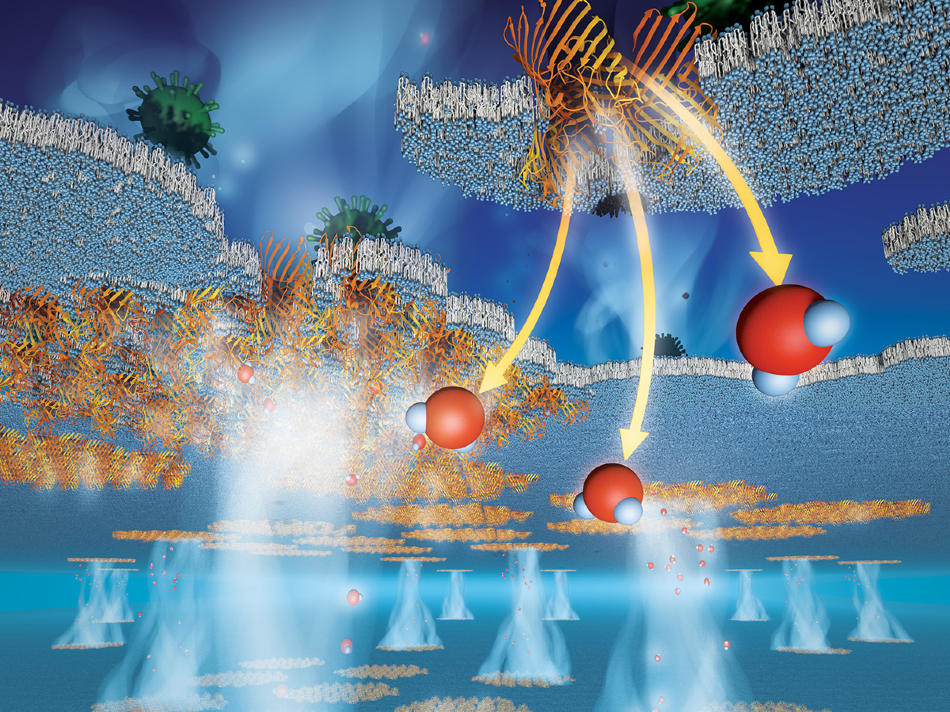Jan 29 2020
A multidisciplinary team, including researchers and engineers, has created a new type of filtration membranes for a wide range of applications—such as contaminant-removal processes, water purification, and small-molecule separations—that perform very well than existing technology and can be quickly produced.
 Protein pores found in cell membranes were incorporated at high density into polymer sheets that were stacked to create highly efficient filtration membranes. Image Credit: Cockrell School of Engineering, The University of Texas at Austin.
Protein pores found in cell membranes were incorporated at high density into polymer sheets that were stacked to create highly efficient filtration membranes. Image Credit: Cockrell School of Engineering, The University of Texas at Austin.
The new filtration membranes could minimize operational costs, energy consumption, and production time in industrial separations.
The researchers headed by Manish Kumar, associate professor in the Cockrell School of Engineering at The University of Texas at Austin, have illustrated their new high-performance membranes in the latest issue of Nature Materials.
The new filtration membranes include pores of density higher than those of commercial membranes and can be produced considerably faster—within just 2 hours—compared to the several-day process that is being used at present.
So far, it has been very difficult to combine protein-based membranes with the technology currently used for industrial separations due to the amount of time required to develop these membranes and the low density of proteins in the developed membranes.
This exhaustive and collaborative research effort involved physicists, engineers, chemists, and biologists from UT Austin, University of Kentucky, Penn State University, University of Notre Dame, and the Applied Biomimetic company.
The study presents the first-ever end-to-end production of a true protein-based separation membrane that has pores with a size of 0.5 to 1.5 nm. A nanometer is only a few times the size of a water molecule and a hundred thousand times smaller compared to the width of a strand of human hair.
The membranes developed by the researchers are biomimetic, that is, they mimic elements or systems of nature, and simulate those naturally occurring in cell membranes to transport water and nutrients.
Recently, the team published another paper that described the inspiration for their technique. Protein pores are formed within the membrane through high-density packing of the protein channels into polymer sheets forms. These pores are analogous to those that exist in human eye lenses but exist inside a nonbiological polymer environment.
The researchers created three different biomimetic membranes and showed a distinctive, sharp, and tunable selectivity with membrane protein channels of three different pore sizes. It is possible to adapt the described methods by inserting protein channels of varying chemistries or pore sizes into polymer matrices to carry out uniquely designed separations.
“In the past, attempts to make biomimetic membranes fell far short of the promise of these materials, demonstrating only two to three times improvement in productivity,” said Yu-Ming Tu, a UT Austin chemical engineering doctoral student and lead on the project.
Our work shows a surprising 20 to 1,000 times improvement in productivity over the commercial membranes. At the same time, we can achieve similar or better separation of small molecules, like sugars and amino acids, from larger molecules, like antibiotics, proteins and viruses.
Yu-Ming Tu, Chemical Engineering Doctoral Student, Cockrell School of Engineering, The University of Texas at Austin
The extremely high density of pore proteins enabled such high productivity. If the size of the membrane was equal to that of a U.S. quarter, roughly 45 trillion proteins can fit onto it; the area of the fabricated membranes were 10–20 times larger.
When compared to traditional filtration membranes with similar nano-sized pores, this pore density is 10–100 times greater. Moreover, all the pores in the membranes are precisely of the same shape and size, enabling them to better retain molecules of preferred sizes.
This is the first time that the promise of biomimetic membranes involving membrane proteins has been translated from the molecular scale to high performance at the membrane scale.
Manish Kumar, Associate Professor, Cockrell School of Engineering, The University of Texas at Austin
Kumar added, “For so long, engineers and scientists have been trying to find solutions to problems only to find out nature has already done it and done it better. The next steps are to see if we can fabricate even larger membranes and to test whether they can be packaged into flat sheet and spiral-wound-type modules like the ones common in industry.”
The National Science Foundation financially supported this study.